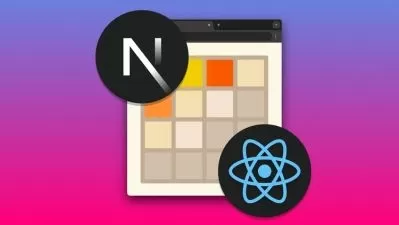The Next.js 13 Bootcamp - The Complete Developer Guide
Laith Harb
14:13:49
Description
Learn all the new features of Next.js 13 by building a restaurant reservation app.
What You'll Learn?
- Build a large production ready application with Next 13
- Handle loading, error, success, and not found states appropriately
- The different rendering modes of React components
- Handle authentication with middleware and server routes
Who is this for?
More details
DescriptionNextJS 13 is an amazing higher level framework, built on top of React, that will totally change the way you think about and build web applications.
In this course, we will learn all about the amazing features NextJS 13 has to offer by building a restaurant reservation application where people can view restaurants and reserve tables.
Firstly we are going to explore the file system in NextJS 13. We are going to learn how to create static and dynamic routes by simply defining files and folders.
We are then going to look at how to handle loading, error, not found, and success states within our application.
Then we will move onto the rendering modes of React components. We will learn about the differences between server and client components and when we should use one over the other.
Following that, we will dive into the server side of NextJS. We will spin up a Postgres database and define the models we need with Prisma (ORM). We will learn how to fetch data from this database, depending on the component we are utilizing.
We will then move to the backend and start defining some authentication endpoints. We will implement authentication for scratch by utilizing middleware, hashers and json web tokens.
The authentication endpoints will be consumed by our client and the user data will be stored globally with the context API.
We then move onto the completing our application by building the availability and scheduling system. We will utilize multiple algorithms and logical thinking to accomplish this.
Who this course is for:
- Next developers that want to learn about all the changes in version 13
- React developers that want to learn a higher level framework
NextJS 13 is an amazing higher level framework, built on top of React, that will totally change the way you think about and build web applications.
In this course, we will learn all about the amazing features NextJS 13 has to offer by building a restaurant reservation application where people can view restaurants and reserve tables.
Firstly we are going to explore the file system in NextJS 13. We are going to learn how to create static and dynamic routes by simply defining files and folders.
We are then going to look at how to handle loading, error, not found, and success states within our application.
Then we will move onto the rendering modes of React components. We will learn about the differences between server and client components and when we should use one over the other.
Following that, we will dive into the server side of NextJS. We will spin up a Postgres database and define the models we need with Prisma (ORM). We will learn how to fetch data from this database, depending on the component we are utilizing.
We will then move to the backend and start defining some authentication endpoints. We will implement authentication for scratch by utilizing middleware, hashers and json web tokens.
The authentication endpoints will be consumed by our client and the user data will be stored globally with the context API.
We then move onto the completing our application by building the availability and scheduling system. We will utilize multiple algorithms and logical thinking to accomplish this.
Who this course is for:
- Next developers that want to learn about all the changes in version 13
- React developers that want to learn a higher level framework
User Reviews
Rating
Laith Harb
Instructor's Courses
Udemy
View courses Udemy- language english
- Training sessions 130
- duration 14:13:49
- Release Date 2023/03/25











